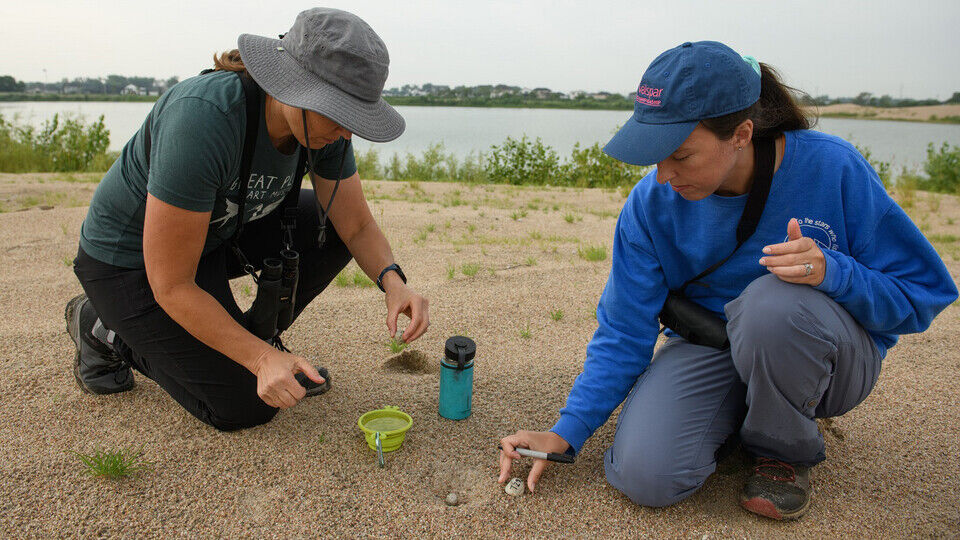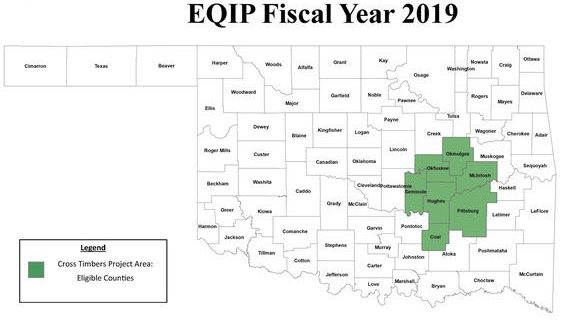Kneeling in an expanse of sand in Saunders County under bright morning light, Alisa Halpin gently held a least tern egg, then placed it in a small cup of water. Her adult daughter, Summer Larkihn, knelt beside her and watched.
If a tern egg sinks to the bottom, it’s relatively young. If it floats, it’s an older egg. Understanding an egg’s age is important information for conservationists working to protect species habitat. That goal is the mission of Nebraska’s long-standing Tern and Plover Conservation Partnership, housed in the University of Nebraska-Lincoln’s School of Natural Resources.
Halpin and Larkihn share an abiding appreciation for Nebraska’s interior least terns and piping plovers, birds long the focus of national conservation protection. Larkihn is a research technician for the conservation partnership, checking nest conditions, installing protective wire structures and recording daily data. In the summers of 2016 and 2017, Halpin had that same job, and she absolutely loved it.
Halpin’s first summer of field work for the conservation partnership in 2016 turned out to be life-changing, providing ongoing inspiration for mother and daughter both. “It was the best summer I ever had,” Halpin said, “and I don’t think anything will beat it.”
She has worked, ever since, in environment-focused professions. She’s now a project scientist focusing on environmental permitting for Olsson, a Lincoln-based civil engineering firm. Halpin has a U.S. Fish and Wildlife recovery permit that allows her to enter breeding areas and pursue conservation work for terns and plovers, primarily at the U.S. Army National Guard site in Ashland, on the Platte River.
Terns and plovers are remarkable, she said—small creatures that migrate enormous distances and build their nests in the seemingly inhospitable habitat of sandy locales near water.
Halpin’s enthusiasm for conservation spurred admiration from Larkihn, who has followed a similar path. In 2022, Larkihn earned a bachelor’s degree in wildlife conservation and wildlife management from the School of Natural Resources—the same degree her mother had earned a decade earlier, when she attended Nebraska as a nontraditional student.
“I’ve always wanted to work with animals and wildlife since I can remember,” Larkihn said. As a student at Lincoln East High School, she saw her mother’s excitement for tern and plover conservation and decided “that’s what I wanted to do, as well.”
“I don’t know how often it happens that a parent and child are in the same field, much less doing the same job and working with the same species,” said Elsa Forsberg, a Husker graduate research assistant who is compiling an analysis of the partnership’s tern and plover data, which goes back to 2008. “It’s cool that they share a fondness for these birds and care to work with them and that Summer’s mother, Alisa, still works with them.”
The conservation partnership, begun in 1999, has proved to be a fruitful collaboration between the School of Natural Resources, sand and gravel mining companies, and housing developers. Additional partners are Nebraska Extension, the Nebraska Game and Parks Commission, U.S. Fish and Wildlife Service and Nebraska Environmental Trust.
The interior least terns and piping plovers lay eggs in “nests” that actually are small depressions in sand. Sand and gravel mining operations incidentally create alternatives to the natural river habitat: sandy expanses resulting from mining activity. Through the partnership, Husker conservationists have worked with private-sector companies to protect the birds that nest at the mines.
The mining employees “are always happy to see us,” Larkihn said. “We even have one place that takes us out on their four-wheeler because we aren’t able to get out there on our own. They meet us every week and drive us out into the sand, which is super-awesome.” Mining employees often notice sand-dwelling nests, pass on that information to the partnership, and take pride in contributing to habitat success, she said.
Once the mining is completed, the sandy areas typically are converted into lakeshore housing developments that continue to host nesting terns and plovers until the housing construction is completed.
Through the cooperative work of Husker staff and the mining companies, the birds usually “do all right until all the houses are built in and the land is bought up,” Forsberg said. Then, often, “there will be a new mine, and the process goes on, hopefully. It’s an interesting situation.”
The primary credit for nurturing this collaborative spirit, Halpin said, goes to Mary Bomberger Brown, an associate professor of practice and coordinator for the conservation partnership who died in 2019.
“Her love of the birds and her excitement, and then going to talk to the sand and gravel mine people and the lakeshore housing owners — I think her spirit and her passion is where everything started,” Halpin said. “People started caring. And I think it only grew from there.”
So far this summer, Forsberg said, the partnership has recorded 290 tern nests and 38 plover nests, which is the second-highest nest count in one year since 2008.
“The off-river sites have changed over the years, and so has the river, but this is the most nests we’d had in several years,” she said.
The highest number of nests the partnership has recorded was in 2015, with 346 tern nests and 71 plover nests.
The federal Endangered Species Act designated the interior least tern in 1985 as endangered. The population at the time was estimated at 2,000 individuals nationally. By 2021, the estimated population had increased to 18,000 individuals, and the tern’s endangered status was removed. The interior least tern is still protected as an endangered bird in Nebraska.
Piping plovers in Nebraska are designated as threatened by both federal and state listings and have not seen significant improvement nationally in numbers since 1985. One estimate put the current U.S. population at about 8,000.
People are the birds’ biggest threat, “but we’re also their greatest help,” Larkihn said, pointing to the conservation partnership’s positive spirit.
Conservation staff have shown great devotion to their mission, Forsberg said. “Over the years, they’ve cared enough to work long hours. We’re out in the heat, we’re out in the rain, dodging storms this summer a lot. It’s the kind of job that takes a lot of diligence and attention to detail.”
That attitude and dedication, she said, “can go through generations. You have the parent that works in this field and then passes down those values to their children. That’s what keeps it going: people that care.”

